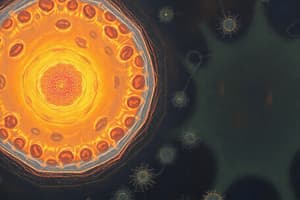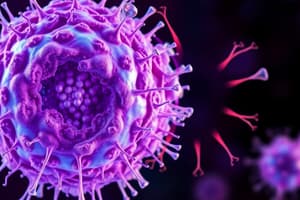Podcast
Questions and Answers
What is the name given to cells which do not have a nucleus or other membrane-bound organelles?
What is the name given to cells which do not have a nucleus or other membrane-bound organelles?
Prokaryotic cells
What does magnification refer to?
What does magnification refer to?
The number of times larger an image is compared with the real size of the object
Who was the first person to describe cells?
Who was the first person to describe cells?
Robert Hooke
Who was the first person to observe living cells?
Who was the first person to observe living cells?
What does the term 'organelle' refer to?
What does the term 'organelle' refer to?
What does resolution refer to?
What does resolution refer to?
What is the function of the nucleus in a cell?
What is the function of the nucleus in a cell?
Why are mitochondria known as the 'powerhouse of the cell'?
Why are mitochondria known as the 'powerhouse of the cell'?
What is the function of chloroplasts?
What is the function of chloroplasts?
How many nanometers are in a millimeter?
How many nanometers are in a millimeter?
What is the equation for calculating magnification?
What is the equation for calculating magnification?
What is the main difference between prokaryotic and eukaryotic cells?
What is the main difference between prokaryotic and eukaryotic cells?
What is the function of the plasma membrane?
What is the function of the plasma membrane?
What is the function of the cytoplasm?
What is the function of the cytoplasm?
What is the function of the rough endoplasmic reticulum?
What is the function of the rough endoplasmic reticulum?
What is the function of the Golgi apparatus?
What is the function of the Golgi apparatus?
What is the function of a vesicle?
What is the function of a vesicle?
What is the function of lysosomes?
What is the function of lysosomes?
What is the function of centrioles?
What is the function of centrioles?
What does the term 'exocytosis' refer to?
What does the term 'exocytosis' refer to?
What is the function of the cell wall?
What is the function of the cell wall?
What is the function of the vacuole in a plant cell?
What is the function of the vacuole in a plant cell?
What is the function of plasmodesmata?
What is the function of plasmodesmata?
What is the function of pits?
What is the function of pits?
What is DNA?
What is DNA?
What is the function of the capsule in some species of bacteria?
What is the function of the capsule in some species of bacteria?
What is the nucleoid?
What is the nucleoid?
What is a plasmid?
What is a plasmid?
What is complementary base pairing?
What is complementary base pairing?
What does the Gram stain do?
What does the Gram stain do?
What is turgor?
What is turgor?
What is the function of palisade mesophyll cells?
What is the function of palisade mesophyll cells?
What is the function of root hair cells?
What is the function of root hair cells?
What is water potential?
What is water potential?
What is the function of sperm cells?
What is the function of sperm cells?
What is the function of the acrosome?
What is the function of the acrosome?
What is the function of the zona pellucida?
What is the function of the zona pellucida?
What is the function of the corona radiata?
What is the function of the corona radiata?
What is the function of red blood cells?
What is the function of red blood cells?
What is the function of haemoglobin?
What is the function of haemoglobin?
Flashcards
Prokaryotic cell
Prokaryotic cell
A cell that does not have a nucleus or other membrane-bound organelles.
Magnification
Magnification
The number of times larger an image is compared with the real size of the object.
1665
1665
Robert Hooke first described cells.
1674-1683
1674-1683
Signup and view all the flashcards
1860
1860
Signup and view all the flashcards
Organelle
Organelle
Signup and view all the flashcards
Resolution
Resolution
Signup and view all the flashcards
Nucleus
Nucleus
Signup and view all the flashcards
Mitochondria
Mitochondria
Signup and view all the flashcards
Chloroplast
Chloroplast
Signup and view all the flashcards
Nanometer (nm)
Nanometer (nm)
Signup and view all the flashcards
Micrometer (um)
Micrometer (um)
Signup and view all the flashcards
Magnification equation
Magnification equation
Signup and view all the flashcards
Eukaryotic
Eukaryotic
Signup and view all the flashcards
plasma membrane
plasma membrane
Signup and view all the flashcards
Cytoplasm
Cytoplasm
Signup and view all the flashcards
Nucleolus
Nucleolus
Signup and view all the flashcards
Rough endoplasmic reticulum (ER)
Rough endoplasmic reticulum (ER)
Signup and view all the flashcards
Smooth Endoplasmic Reticulum
Smooth Endoplasmic Reticulum
Signup and view all the flashcards
Golgi apparatus
Golgi apparatus
Signup and view all the flashcards
Vesicle
Vesicle
Signup and view all the flashcards
Lysosomes
Lysosomes
Signup and view all the flashcards
Ribosomes
Ribosomes
Signup and view all the flashcards
Mitochondria
Mitochondria
Signup and view all the flashcards
Centrioles
Centrioles
Signup and view all the flashcards
Exocytosis
Exocytosis
Signup and view all the flashcards
cell wall
cell wall
Signup and view all the flashcards
Vacuole
Vacuole
Signup and view all the flashcards
Tonoplast
Tonoplast
Signup and view all the flashcards
Amyloplasts
Amyloplasts
Signup and view all the flashcards
Plasmodesmata
Plasmodesmata
Signup and view all the flashcards
Pits
Pits
Signup and view all the flashcards
DNA
DNA
Signup and view all the flashcards
Capsule
Capsule
Signup and view all the flashcards
Nucleoid
Nucleoid
Signup and view all the flashcards
Plasmid
Plasmid
Signup and view all the flashcards
Complementary base pairing
Complementary base pairing
Signup and view all the flashcards
RNA
RNA
Signup and view all the flashcards
Gram stain
Gram stain
Signup and view all the flashcards
Turgor
Turgor
Signup and view all the flashcards
Study Notes
Prokaryotic Cells
- Prokaryotic cells lack a nucleus and membrane-bound organelles.
Cell Observation Milestones
- 1665: Robert Hooke described cells.
- 1674-1683: Anton van Leeuwenhoek observed bacteria and protoctista.
- 1860: Louis Pasteur disproved spontaneous generation.
Cell Structure & Function
- Organelle: A specialized structure within a eukaryotic cell performing specific functions.
- Nucleus: Control center of eukaryotic cells, containing DNA and RNA.
- Mitochondria: Powerhouse of cells; site of aerobic respiration and ATP production.
- Chloroplast: Site of photosynthesis in plant and algal cells.
- Plasma membrane: Selectively permeable phospholipid bilayer; regulates cellular transport.
- Cytoplasm: Jelly-like fluid filling the cell; maintains shape and stores chemicals.
- Nucleolus: Inside the nucleus, produces ribosomes and RNA.
- Rough ER: Studded with ribosomes; synthesizes and transports proteins.
- Smooth ER: Creates lipids and carbohydrates.
- Golgi apparatus: Modifies and packages proteins for export.
- Vesicle: Membrane-bound sac for cellular transport.
- Lysosomes: Contain digestive enzymes.
- Ribosomes: Non-membrane-bound structures; site of protein synthesis.
- Centrioles: Involved in cell division.
- Exocytosis: Release of substances from a cell via vesicle fusion.
- Cell Wall (plant cells): Rigid structure providing support; sieve-like network.
- Vacuole (plant cells): Membrane-bound sac containing cell sap, maintaining cell framework.
- Tonoplast: Membrane surrounding the central vacuole (plant cells) with controlled permeability.
- Amyloplasts: Store starch in plant cells.
- Plasmodesmata: Channels connecting plant cells for transport and communication.
- Pits: Pores in cell walls allowing water movement.
Prokaryotic Structure
- Capsule: Slimy layer outside the cell wall (some bacteria).
- Nucleoid: Region in prokaryotic cells containing DNA without a nucleus membrane.
- Plasmid: Small loop of DNA in prokaryotic cells.
DNA & RNA
- DNA: Deoxyribonucleic acid; hereditary material.
- RNA: Ribonucleic acid; molecule with nucleotide chains.
Staining Methods
- Gram stain: Differentiates between Gram-positive (purple) and Gram-negative (pink) bacterial cell walls.
Cell Processes
- Magnification: The number of times larger an image is compared to real size.
- Resolution: The ability to distinguish between close objects.
- Magnification equation: Image size/actual size
- Turgor: Pressure exerted by a fluid inside a structure.
- Water potential: Likelihood of water molecules diffusing into or out of a solution.
Specialized Plant Cells
- Palisade mesophyll: Column-shaped cells in leaves with high chlorophyll concentration; maximizes photosynthesis.
- Root hair cell: Absorbs water and nutrients from the soil; large surface area.
Animal Cells
- Sperm cells: Male gametes; include acrosome, head, neck, middle piece, and tail.
- Egg cells: Female gametes; include zona pellucida, nucleus, and cytoplasm.
- Red blood cells: Biconcave shape, carry oxygen; lack a nucleus.
- White blood cells: Fight infection.
- Epithelial tissue: Covers body surfaces.
- Squamous epithelial: Single-layered cells forming the epidermis.
- Ciliated columnar epithelium: Moves debris with cilia.
- Endothelial tissue: Lines blood and lymph vessels.
- Lumen: Space within a tube or organ.
- Artery: Blood vessel carrying blood away from the heart.
- Muscle tissue: Contracts to move body parts.
- Skeletal muscle tissue: Voluntary muscle for body movement; contains sarcolemma and myofibrils.
- Slow-twitch muscle fibers: Endurance; utilize aerobic respiration.
- Fast-twitch muscle fibers: Speed and strength; fatigue quickly.
- ATP: Energy source for cells.
- Aerobic respiration: Respiration requiring oxygen.
- Hydrolysis: Breaking down molecules using water.
- Glycogen: Glucose storage form.
- Anaerobic respiration: Respiration without oxygen.
Nervous Tissue
- Nervous tissue: Transmits nerve impulses.
- CNS: Central nervous system (brain and spinal cord).
- Neurons: Individual nerve cells.
- Dendrites: Receive information.
- Axon: Carries impulses away from the cell body.
- Schwann cells: Form myelin sheaths.
- Myelin sheath: Insulates axons; speeds up nerve impulses.
- Node of Ranvier: Gaps in myelin sheath.
- Axon terminal: End of axon, releases neurotransmitters.
- Resting potential: Electrical charge across a resting neuron membrane.
- Action potential: Nerve impulse; rapid change in electrical charge.
- mV: Millivolts; unit of potential difference.
- EEG: Electroencephalogram; measures brainwave activity.
- Neurotransmitters: Chemical messengers.
- Synaptic cleft: Gap between neurons.
Diseases & Drugs
- Alzheimer's disease: Progressive brain disorder affecting memory.
- Clinical depression: Mental disorder characterized by sustained sadness.
- MDMA (Ecstasy): Synthetic drug with stimulant and psychedelic effects.
- SSRIs: Selective serotonin reuptake inhibitors, e.g. Prozac.
- Atherosclerosis: Buildup of fatty material in artery walls.
- Atherosclerosis risk factors: Nicotine, diet, hypertension, diabetes, obesity, stress, sedentary lifestyle.
- Parkinson's disease: Neurological disorder affecting movement.
- L-dopa: Precursor to dopamine; crosses blood-brain barrier.
- Action potential propagation: Transmission of the action potential down the axon, influence of diameter and myelin sheath.
Studying That Suits You
Use AI to generate personalized quizzes and flashcards to suit your learning preferences.
Description
Explore the fundamental differences between prokaryotic and eukaryotic cells with this quiz. Learn about cell structures, their functions, and historic milestones in cell observation. This quiz is perfect for students seeking to reinforce their understanding of cellular biology.




